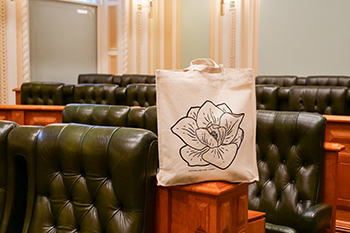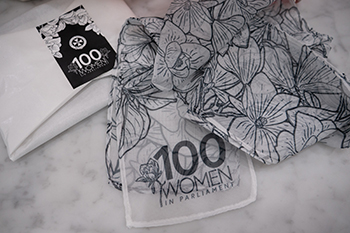-
Visit and learn
- Message from the Speaker
- About Us
- Visitors
- Visit the Public Gallery
- Visit our Gift Shop
- Have Your Say
- Get Involved
- Education and Learning
- History
- Heritage Collections
- Preservation of our Heritage
- Regional Sittings
- CPA Australia and Pacific Regional Conference
- Publications and Reports
- Speakers' Corner
- Opening of the 58th Parliament
- Parliamentary Annexe Reparation and Refurbishment
- Contact Us
Celebrating 100 Women in Queensland Parliament
At the Opening of the 58th Parliament in 2024, we marked a historic milestone as over 100 women have now been elected to Queensland Parliament.
We honour the trailblazers who paved the way and those who continue to inspire future generations.
Women of the 58th Queensland Parliament
In celebration of International Women's Day 2025, watch this video as current female Members share their advice, reflections, and insights on their journeys in Parliament. Their stories highlight the importance of equality, representation, and empowering the next generation of women in leadership.
Fundamental Right?
During the 19th century, the right to vote was perceived by women as fundamental to addressing the challenges they faced in their daily lives.
Suffrage groups, such as the Women’s Suffrage League, advocated for the advancement of women through the removal of economic, legal, and political barriers that hindered their full participation in society.
In the late 1800s, various legislative reforms were sought to address issues affecting women, including[i]:
- eliminating poverty
- educating women
- improving working conditions
- equal pay.
In 1902, Australia became the second country in the world to give women the right to vote, following New Zealand in 1893.
Women at a Polling Booth in George Street in 1907
Legislation
The Elections Acts Amendment Act 1905 (Qld) was assented to on 25 January 1905, granting most Queensland women the right to vote in their own state.[ii]
Indigenous persons of Australia, Asia, Africa, or the Islands of the Pacific were not entitled to be named on the electoral roll.[iii]
The Elections Act 1915 (Qld) was assented to on 23 November 1915, consolidating and amending laws relating to Parliamentary elections, including[iv]:
- the eligibility of women, enrolled in any electoral district in Queensland, to stand as candidates for election to the Legislative Assembly. They remained ineligible to be appointed to the Legislative Council,[v]5 and
- the continued disqualification of Indigenous Australians and certain non-European persons from voting:
no aboriginal native of Australia, Asia, Africa or the Islands of the Pacific shall be qualified to be enrolled upon any electoral roll.[vi]
On 17 December 1965, the Elections Act Amendment Act 1965 (Qld) amended the Elections Act 1915 to 1962 (Qld),[vii] granting Aboriginal and Torres Strait Islanders, both male and female, the right to vote at their state’s elections.[viii]
Significant Firsts
First Female Member
Irene Longman (1877–1964) was a pioneering Australian politician, educator, and social reformer, and the first woman to be elected to the Queensland Parliament.
"There is no true democracy when only one sex is directly represented in the Government of the country."
First Female Premier
Anna Bligh AC was appointed Queensland’s first female premier in 2007. Following her government’s re-election in 2009, Bligh achieved another milestone as the first woman in Australia to be popularly elected as a state Premier.
First Female Speaker
Fiona Simpson served as Speaker of the Queensland Legislative Assembly from 2012 to 2015, becoming the first woman appointed to this role.
First Female Leader of a Party
Joan Sheldon AM made history as Queensland’s first female leader of a political party. Sheldon was the Leader of the Liberal Party from 1991 to 1998.
First Female Premier from Opposition
Annastacia Palaszczuk was the first woman to win three consecutive elections, to win an election from opposition, and the first to form a cabinet in Australia with a majority of female ministers.
First Female Aboriginal Australian MP
Leeanne Enoch made history in 2015 as the first Aboriginal Australian woman elected to the Queensland Parliament and Queensland’s first Aboriginal Australian minister.
First Female Torres Strait Islander MP
Cynthia Lui made history in 2017 as the first Torres Strait Islander elected to any Australian parliament.
Visit the Exhibit and Shop Limited Editions
To honour the trailblazers who paved the way and those who continue to inspire future generations, Queensland Parliament has unveiled a special exhibit on Level 3 of the Parliamentary Annexe. This display highlights the first women in key parliamentary roles and features a complete list of the 110 female Members elected since Irene Longman made history in 1929.
You can also take home a limited-edition memento of this milestone, including tote bags, scarves, and a special locally produced pink gin liquor, available at the Gift Shop and Lucinda Bar.


Woman Members of Queensland Parliament
Download the list of woman Members of Queensland Parliament.
|
1 |
LONGMAN, IM |
38 |
LEE LONG, RT |
75 |
ENOCH, LM |
|
2 |
JORDAN, EV |
39 |
MALE, CT |
76 |
FENTIMAN, SM |
|
3 |
KIPPIN, VA |
40 |
MOLLOY, C |
77 |
GILBERT, JC |
|
4 |
KYBURZ, RA |
41 |
NOLAN, RG |
78 |
HOWARD, JR |
|
5 |
NELSON, BA |
42 |
PHILLIPS, AF |
79 |
LAUGA, BL |
|
6 |
CHAPMAN, YA |
43 |
REILLY, DA |
80 |
LEAHY, A |
|
7 |
HARVEY, LT |
44 |
ROBERTS, EM |
81 |
LINARD, LM |
|
8 |
WARNER, AM |
45 |
SCOTT, CM |
82 |
O’ROURKE, CJ |
|
9 |
MCCAULEY, DE |
46 |
SCOTT, DC |
83 |
PEASE, JE |
|
10 |
GAMIN, JM |
47 |
SMITH, CA |
84 |
BOLTON, SL |
|
11 |
BIRD, LR |
48 |
STONE, BG |
85 |
LUI, CL |
|
12 |
CLARK, LA |
49 |
SULLIVAN, CE |
86 |
MCMAHON, MF |
|
13 |
EDMOND, WM |
50 |
MENKENS, RN |
87 |
MCMILLAN, CP |
|
14 |
POWER, LJ |
51 |
STUCKEY, JA |
88 |
MULLEN, C |
|
15 |
ROBSON, MJ |
52 |
DARLING, VE |
89 |
PUGH, JC |
|
16 |
SPENCE, JC |
53 |
JONES, KJ |
90 |
RICHARDS, KE |
|
17 |
WOODGATE, MR |
54 |
KIERNAN, BM |
91 |
SCANLON, MAJ |
|
18 |
SHELDON, JM |
55 |
PALASZCZUK, A |
92 |
WILSON, SM |
|
19 |
ROSE, M |
56 |
VAN LITSENBURG, ECM |
93 |
GERBER, LJ |
|
20 |
SIMPSON, FS |
57 |
GRACE, I |
94 |
BUSH, J |
|
21 |
BLIGH, AM |
58 |
BATES, RM |
95 |
CAMM, A |
|
22 |
CUNNINGHAM, EA |
59 |
DAVIS, TE |
96 |
KING, A |
|
23 |
WARWICK, LR |
60 |
FARMER, DE |
97 |
MACMAHON, A |
|
24 |
WILSON, NKW |
61 |
JOHNSTONE, AA |
98 |
NIGHTINGALE, M |
|
25 |
LAVARCH, LD |
62 |
O’NEILL, M-A |
99 |
ASIF, B |
|
26 |
ATTWOOD, JM |
63 |
BARTON, VM |
100 |
BOURNE, W |
|
27 |
BOYLE, DC |
64 |
FRANCE, LN |
101 |
DOOLAN, AS |
|
28 |
CUNNINGHAM, JI |
65 |
FRECKLINGTON, DK |
102 |
DOOLEY, K-A |
|
29 |
NELSON-CARR, LH |
66 |
MADDERN, MA |
103 |
JAMES, BG |
|
30 |
PRATT, DR |
67 |
MILLARD, KN |
104 |
KIRKLAND, DM |
|
31 |
STRUTHERS, KL |
68 |
OSTAPOVITCH, FK |
105 |
MARR, ND |
|
32 |
MILLER, J-AR |
69 |
RICE, S |
106 |
MORTON, KJ |
|
33 |
BARRY, VL |
70 |
SMITH, T |
107 |
O’SHEA, BF |
|
34 |
CLARK, EA |
71 |
TRAD, JA |
108 |
POOLE, JM |
|
35 |
CROFT, P-K |
72 |
D’ATH, YM |
109 |
STOKER, AJ |
|
36 |
JARRATT, JH |
73 |
BOYD, NA |
110 |
YOUNG, R |
|
37 |
KEECH, MM |
74 |
DONALDSON, LE |
|
|
[i] Elections Acts Amendment Act 1905 (Qld); Queensland Government. Office for Women, 'Queensland Women's Right to Vote', Information Paper, No 1, 2005, p 2-3.
[ii] Elections Acts Amendment Act 1905 (Qld); Queensland Government. Office for Women, 'Queensland Women's Right to Vote', Information Paper, No 1, 2005, p 4.
[iii] Elections Acts Amendment Act 1905 (Qld), s7; Queensland Parliament, 'Queensland Electoral And Parliamentary history: key dates and events', Factsheet, 3.1, February 2020.
[iv] Elections Act 1915 (Qld).
[v] Elections Act 1915 (Qld), ss9 & 39; Queensland Parliament, 'Queensland Electoral And Parliamentary history: key dates and events', Factsheet, 3.1, February 2020.
[vi] Elections Act 1915 (Qld), s11; Queensland Government. Office for Women, 'Queensland Women's Right to Vote', Information Paper, No 1, 2005, p 3.
[vii] Elections Act Amendment Act 1965 (Qld).
[viii] National Museum of Australia, ‘Indigenous Australians’ right to vote’, updated 16 May 2023; Queensland Government. Office for Women, 'Queensland Women's Right to Vote', Information Paper, No 1, 2005, p 4.




